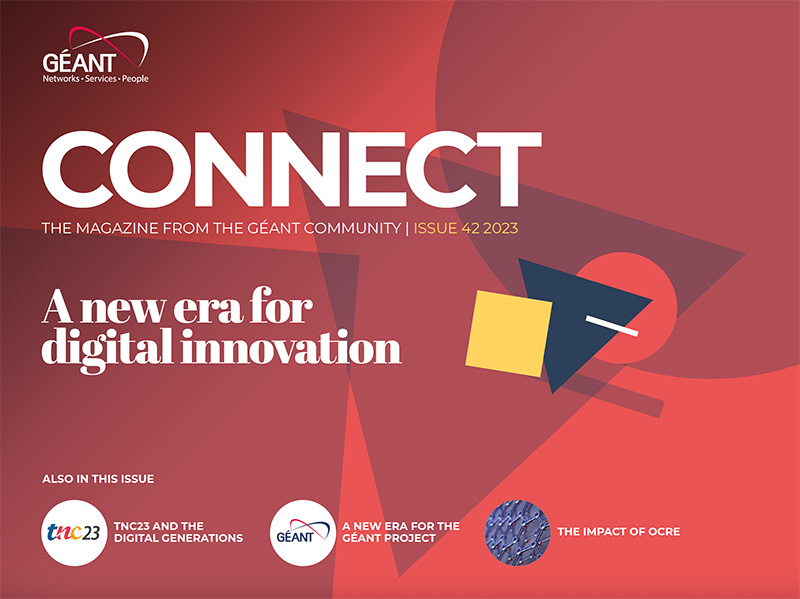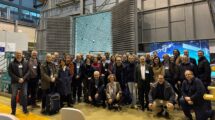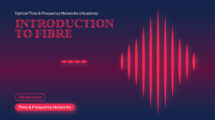The GN5-IC1 project aims to extend and secure the global reach of the GÉANT network. Leonardo Marino, Task Leader for Communications and Dissemination, speaks with project members about various aspects of the project.
Interviewees (all from GÉANT) – Veronika Di Luna, GN5-IC1 Project Manager; Sebastiano Buscaglione, GN5-IC1 TL Planning and Method Development; Tom Fryer, GN5-IC1 TL Intercontinental Partner Engagement and User Need Assessment; Fedor Bruinewoud, GN5-IC1 TL Procurement
Can you tell us briefly what the GN5-IC1 project is and what it plans to achieve?
Veronika Di Luna: GN5-IC1 is a new project in GÉANT’s portfolio. It’s part of the GN5 Framework Partnership Agreement in Horizon Europe, and sister project to GN5-1 (see here for the CONNECT42 article on GN5-1). Its ambition is to plan and implement a first set of intercontinental connectivity investments, as well as to put in place a mid- to long-term investment plan for GÉANT.
So, why is GÉANT upgrading its intercontinental connectivity? And why do we need GN5-IC1?
Tom Fryer: With 25% of traffic across the GÉANT backbone either being destined for, or having an origin outside of the GÉANT membership, intercontinental connectivity is an important part of our strategy. Historically, we worked on a regional basis, collaborating with individual organisations on their needs for connectivity with GÉANT and then gradually establishing additional arrangements for backup. What we have been missing however is a close and complete analysis of the overall intercontinental connectivity we have in place, of backup arrangements, of potential risks, of the contracts’ duration, and finally of the gaps that we need to fill. That’s where GN5-IC1 comes in: this project will produce a reference topology to help us have a clear view of how our connectivity should be developed and of what should be prioritised.
Sebastiano Buscaglione: GN5-IC1 offers us a good opportunity to improve the state of our network. Currently, GÉANT is paying directly only for a small amount of the connectivity that finally lands on the GÉANT network. We now want to participate more actively and have more control on how connectivity between GÉANT and the other world regions is achieved.
Veronika Di Luna: Ultimately, we need the GN5-IC1 project in the same way we as citizens always require better infrastructure of any type: to enhance collaboration, foster mobility, and improve the exchange of ideas. Specifically, GN5-IC1 will help to progress research and education on a global scale.
The project only started a few months ago, but you have already been quite busy… Can you tell us what has been done so far and what we can expect in the next few months?
Fedor Bruinewoud: Well, our preparatory work actually started earlier. Due to expiring contracts, we had an urgency to renew connectivity to the Asia-Pacific region, which is one of the regions we exchange the most traffic with, together with North America. In order to do that, before summer we engaged with the market and had conference calls with providers to explain what we do, our intentions and objectives, and finally to collaborate in preparation for our upcoming tender. As a result, we are now establishing new connectivity between our backbone network in Marseille and Singapore, with a 100G leased line, based on a seven-year IRU (Indefeasible Right of Use) with the option of a three-year extension. This will also allow us to renew connectivity with our Chinese partner CSTNET, who will provide an equivalent link from Beijing to Singapore, with the resulting interconnection replacing the existing 10Gbps GÉANT-CSTNET link. The second major part of our work will be transatlantic, and specifically an upgrade of connectivity between North America and our European backbone network. In the first quarter of this year, we started to engage with infrastructure providers to discuss about obtaining Terabit capacity, preferably via a spectrum solution.
Sebastiano Buscaglione: I believe that what we are setting up under GN5-IC1 with North America is going to be a game-changer for the connectivity between the two continents. Obtaining spectrum will mean having terabit capacity, and potentially controlled costs over a term of at least 15 years. That is quite a big change from where we are today.
Why did you decide to target the regions of the Asia-Pacific and of North America in this first phase? What is the rationale behind your decisions?
Sebastiano Buscaglione: It’s natural for us to start from those two regions if we consider that 75% of GÉANT’s intercontinental traffic goes toward North America and 19% goes to the Asia-Pacific region, and that we already have in place a big investment towards Latin America via the BELLA programme.
Tom Fryer: Our long-term planning will result instead from the reference topology that we’re aiming to produce. Of course, this work will require continuous revisions and updates, as it will be laying groundwork for our future and beyond the end of the project. The key will be understanding the user needs. That requires our own understanding of big science projects, of where the infrastructure is, where the collaborations are, and what we predict the data flows are going to be. And this goes above and beyond our forecast of around 30 to 35% average growth in our intercontinental traffic year on year. In particular, we will need to cater for new projects on which we are expecting larger steps in growth, in fields like astronomy, fusion science research, or with the High Luminosity LHC coming online, which will significantly increase traffic. We will also speak to the European NRENs to find out about specific collaborations that will need support, and at the same time we will work with our research engagement, partner relations and international relations teams to get the full picture from our international partners. Finally, the NIAC (Network Infrastructure Advisory Committee) will support us in our decisions, advising on our priorities and longer-term planning.
What would you say is the key strength of this project, according to you?
Fedor Bruinewoud: Probably building on the relationship with the suppliers obtained during GN4-3N. That makes it easier to engage with them and to point out our objectives and how we would like to achieve them.
Veronika Di Luna: For me the real strength of GN5-IC1 lies in this team. Task leads have been either an integral part of GN4-3N or BELLA, and GN5-IC1 will build on that experience.
Tom Fryer: I agree with Veronika, I’m already enjoying very much the collaboration with this team. We’re a relatively small group, but we complement each other very well and we have lots of support from within GÉANT.
Why is this project a paradigm shift for GÉANT’s Intercontinental Connectivity?
Sebastiano Buscaglione: I think that the biggest shift with GN5-IC1 is on the long-term perspective with regards to acquiring connectivity infrastructure to other world regions. Historically we have had a pay-as-you-grow model, acquiring connectivity from the market as we needed it, based on shorter-term contracts. In our environment however, we can have the privilege to look at the long-term perspective, because we support big science projects that are generally long-term endeavours. As we saw in GN4-3N, looking at the longer-term perspective enables us to optimise our infrastructure differently, better, and with less constraints.
Tom Fryer: Additionally, understanding the connectivity needs for the next 10-15 years – or potentially even longer – will help us guide conversations towards future funding, be it via GN5, or be it through separate programmes, as for instance Global Digital Gateway programmes, which are also looking at longer-term connectivity and at European ownership of that connectivity.
Veronika Di Luna: I also think that GÉANT has now matured to a stage in which we are able to make big long-term investments on intercontinental links. Through GN5-IC1, GN4-3N, international projects as BELLA, EaPConnect and AfricaConnect, and potentially in EC Global Gateway endeavours, such as the Medusa submarine cable system in the Mediterranean, we are gaining expertise and exposure, which we can then use as a know-how. It’s thanks to this know-how that GÉANT is increasingly a trusted partner of the EC for R&E connectivity.
How will you ensure long term-sustainability of the new routes?
Sebastiano Buscaglione: We will invest in places where we have many opportunities to leverage investments. There is not just one reason for getting to a place: we will choose locations where we expect to have a need in connectivity and favour big international hubs so that over time, we will have the opportunity to leverage connectivity through different projects and we will have different means to connect various regional networks. Moving to IRU is another key point for long-term sustainability: with a substantial CapEx (Capital Expenditure) investment at the start, the OpEx cost (Operating Expenditure) will then become significantly lower than when buying on short-term. Fixing the contract costs for 15 years will allow us to plan accordingly, provide us with security in term of costs and protect us from market fluctuations.
Fedor Bruinewoud: Another fundamental aspect is securing spectral bandwidth and making use of the advantages of future technology, by increasing capacity over time over the same bandwidth.
Sebastiano Buscaglione: We’re trying to make investments that are as technology-agnostic as possible. That’s why we are acquiring spectrum: because by allowing to run different types of technologies on top of it, it has the potential to remain valid over time.
Is there anything that you’re particularly looking forward to in this project?
Tom Fryer: I think it’s going to be very interesting to see full picture portrayed by the reference topology. Then again, I’m already enjoying the collaboration with this team and looking forward to progress work in this collaborative environment.
Fedor Bruinewoud: I’m personally really looking forward to engaging with the providers on our transatlantic connectivity. We have now provided them with a high-level overview of what we would like to achieve, but the solutions they will propose will need further discussions and iterations before we can go to tender. Ultimately through this project, I would like us to be able to shortlist a number of providers to work in close cooperation with, all offering different types of solutions that can fit us.
Sebastiano Buscaglione: For me a very interesting aspect is that – following from our work in projects as GN4-3N, BELLA, EaPConnect – this project will continue to raise our profile as an investor in connectivity. We inevitably spend a lot of money in connectivity already. But with GN5-IC1 rather than being only a pay-as-you-grow customer, GÉANT is increasingly becoming a player within the environment. By being able to sit at the right tables, with the people and companies designing the infrastructure, and of course thanks to the generous funding provided by the EC, we get the opportunity to effectively make investments that we would never be able to make otherwise. Having this position within the environment is very important and will provide us with interesting opportunities in the future.
Veronika Di Luna: And for me, well… you know how sometimes you can get to a moment of sudden realisation that you have discovered something new and interesting and unexpected? I think this project has a great potential to make that happen. We’re venturing into uncharted territories, and I’m pretty excited of what we could discover through this project.
For further information about GN5-IC1 visit https://network.geant.org/gn5-ic1
To check out GÉANT global connectivity map and download it, visit https://network.geant.org/international_connectivity/

Read or download the full magazine here






